Istanbul, a city where continents collide, offers flavors as rich and diverse as its history. From street food to Michelin stars, Turkish food offers some of the eating experiences we at Cerca like most – long tables piled with small dishes with dips and breads and salty cheeses, platters of fish and skewered meats, sliced and layered vegetables served as pickles or roasted until melting, small boats of sauce and pinch bowls of spice and tureens of olives.
Istanbul is a complicated city, situated as it is at the meeting place not just of geographies, but of cultures and histories. Food is a perfect way to begin to understand the layers in this magical place. Here’s a 7 step guide to help you plan a delicious cultural immersion.
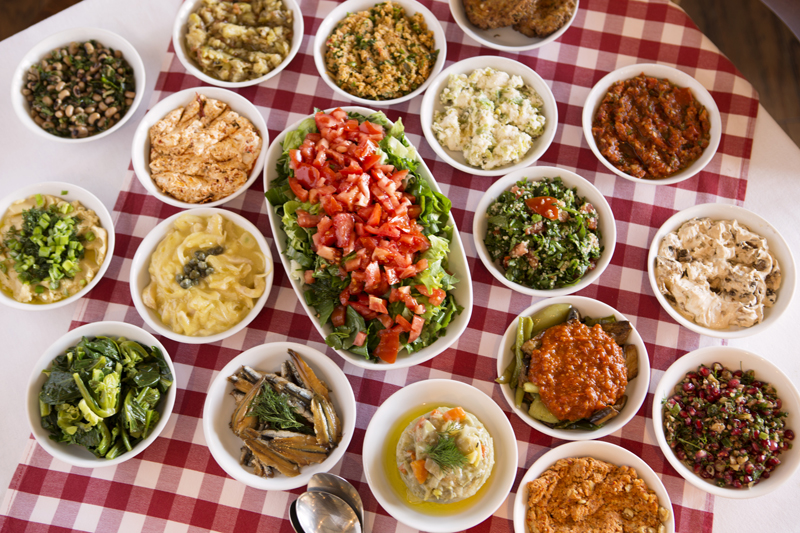
STEP 1: The Meyhane
A meyhane is a traditional Turkish tavern where people gather to enjoy meze, seafood, and rakı (anise-flavored spirit) in a warm, social setting. The word “meyhane” comes from Persian and translates roughly to “house of wine,” but in Turkey, rakı is the dominant drink.
The pairing of meze and rakı is about balance. Rakı has a bold, licorice-like taste, a slightly oily texture, and a high alcohol content (40-45% ABV). Meze, on the other hand, provides contrast and harmony:
Saltiness (cheese, fish, olives) complements the mild bitterness of rakı.
Acidity (pickles, lemon, yogurt-based meze) cuts through rakı’s heaviness.
Spice (red pepper, garlic, herbs) counteracts rakı’s cooling anise tones.
Fat & Richness (olive oil, tahini, grilled meats) soften rakı’s intensity.
The Story of the Meyhane
Meyhanes have been a part of Turkish social life for centuries, dating back to the Byzantine and Ottoman periods. They were originally frequented by non-Muslim communities, but over time, they became an integral part of Istanbul’s nightlife for all who enjoy good food, conversation, and music.
The experience of a meyhane is about slow dining and deep conversations. People linger over their meals, toasting with rakı, which is often diluted with water and turns a milky white color, earning the nickname “lion’s milk” (aslan sütü). A proper meyhane visit is unhurried, focusing on friendship, storytelling, and enjoying every bite.
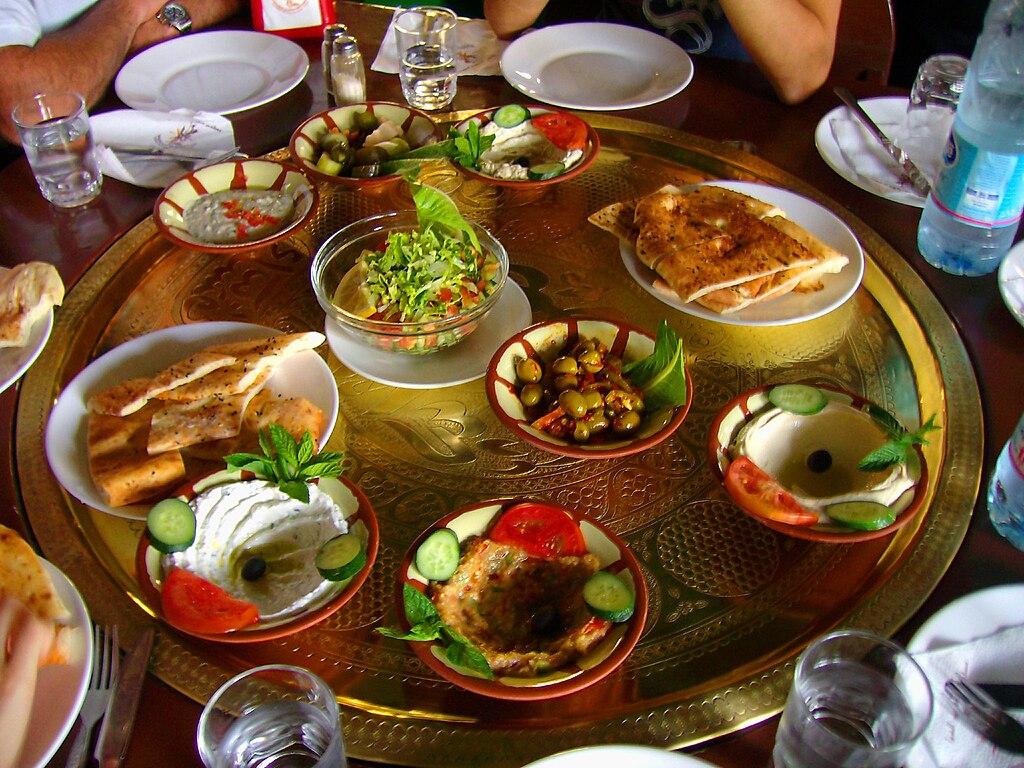
MEZE
A meal at a meyhane typically begins with a selection of meze, small appetizers meant to be shared. Some must-try dishes include:
Haydari – A thick, garlicky yogurt dip
Şakşuka – Fried eggplant with a tangy tomato sauce
Ezme – A spicy tomato and pepper paste
Lakerda – Cured bonito fish
Kavun ve Beyaz Peynir – Melon with white cheese, a classic pairing with rakı
Kalamar Tava – Fried calamari, served with garlic yogurt sauce
Midye Dolma – Stuffed mussels with spiced rice
For the main course, seafood is king at most meyhanes. Grilled sea bass, sea bream, or shrimp in olive oil or köfte (Turkish meatballs flavored with cumin and spices) or grilled lamb chops.
The meal often ends with tahini halva, fresh fruit, or a cup of Turkish coffee.
Where:
Karaköy Lokantası – A refined meyhane with a modern twist on Turkish tavern culture.
İnciraltı Meyhanesi (Karaköy) – A rustic spot with a nostalgic atmosphere and top-notch meze.
Asmalı Cavit (Beyoğlu) – A local favorite with traditional meze and expertly grilled seafood.
Demeti Meyhanesi (Cihangir) – Offers a cozy setting with stunning Bosphorus views.
Eleos (Beyoğlu & Yeşilköy) – A seafood meyhane with Greek-Turkish influences, perfect for a rakı-infused evening.
Step 2: Traditional Turkish Breakfast (Kahvaltı)

The term “kahvaltı” translates to “before coffee,” underscoring the importance of this morning feast. A traditional Turkish breakfast abundant, with a mix of flavors and textures, featuring an array of cheeses, olives, fresh bread, honey, jams, and eggs.
The Turkish breakfast reflects the country’s agrarian roots, with each component showcasing regional produce. Cheeses like beyaz peynir (white cheese) and kaşar (aged cheese) hail from different parts of Turkey, while olives from the Aegean coast and honey from the Black Sea region highlight the nation’s diverse agricultural heritage. Sharing breakfast is a social affair, fostering community and connection.
Where to Experience: For an authentic kahvaltı experience, head to Van Kahvaltı Evi in the Cihangir district. This establishment offers a spread reminiscent of the Van region, known for its rich breakfast traditions.
Another notable spot is Çakmak Kahvaltı Salonu in Beşiktaş, where locals gather to enjoy muhlama, a fondue-like dish made with cheese and cornmeal.
Step 3: Street Food
Simit
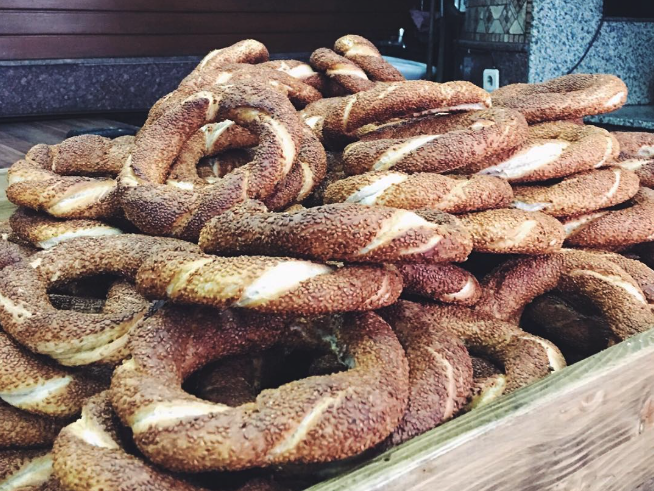
No visit to Istanbul is complete without tasting simit, the city’s ubiquitous street food. This sesame-crusted bread ring is often enjoyed on the go, offering a quick and delicious snack.
Cultural Significance: Simit has been a staple in Turkish cuisine for centuries, symbolizing sustenance and simplicity. Its origins trace back to the Ottoman era, and it remains a beloved snack across all social strata. The act of purchasing simit from street vendors, known as “simitçi,” is a daily ritual for many Istanbulites.
Where to get it: Galata Simitçisi : While simit is available throughout the city, for a fresh and warm experience, visit this historic shop near the Galata Tower. Here, you can enjoy your simit with a cup of Turkish tea, watching the world go by.
Balık Ekmek: Fish Sandwich

A beloved street food, balık ekmek (fish sandwich – which actually translates to “fish bread”) is synonymous with Istanbul’s historic connection to the sea. Freshly grilled mackerel, served on a crusty roll with onions and greens, sometimes a mix of other pickled and fresh vegetables, sweet and tangy pomegranate molasses, and a shake of Turkish chili flakes.
Where to Experience: Visit the Eminönü waterfront, where vendors serve balık ekmek straight from their boats or anywhere near the fish market in Karaköy, pick from your choice of stalls and street vendors.
Step 4: Kebabs
Kebabs are perhaps the most internationally recognized Turkish dish, with a variety that goes beyond the ubiquitous döner. From the spicy Adana kebab to the yogurt-covered İskender kebab, each variant tells a story of regional flavors.
Turkish kebabs are a cornerstone of Turkish cuisine, with each region offering its own unique flavors, techniques, and traditions. While the word “kebab” often brings to mind skewered and grilled meat, in Turkey, the variety is far more complex, incorporating different cooking methods, regional spices, and centuries-old culinary heritage.
There are so many, but here are our favorites:

Adana Kebab
🔥 Spicy, Charcoal-Grilled, Minced Lamb
Adana Kebab is one of the most famous Turkish kebabs, originating from the southern city of Adana. Made with hand-chopped lamb, tail fat, and spicy red pepper flakes, it’s shaped onto large skewers and grilled over an open flame. Best With: Lavaş (flatbread), grilled tomatoes, and sumac onions.
Ocakbaşı – One of Istanbul’s best for authentic Adana kebabs.

Urfa Keba
Mild, Charcoal-Grilled, Minced Lamb
Urfa Kebab is the milder cousin of Adana Kebab. Also made from minced lamb and fat, it omits the heavy use of chili, focusing on a delicate balance of spices. Best With: Yogurt-based meze like haydari, grilled vegetables, and lavash bread.
Zübeyir Ocakbaşı, Taksim – A legendary spot for traditional kebabs in Istanbul.

Döner Kebab
Rotisserie-Grilled Layers of Meat
The famous döner kebab consists of thinly sliced marinated meat (lamb, beef, or chicken) stacked on a vertical spit and slowly roasted. Variations: Served in pita (dürüm döner), plated with rice (porsiyon döner), as a sandwich (ekmek arası döner).
Bayramoğlu Döner – One of Istanbul’s best döner joints.
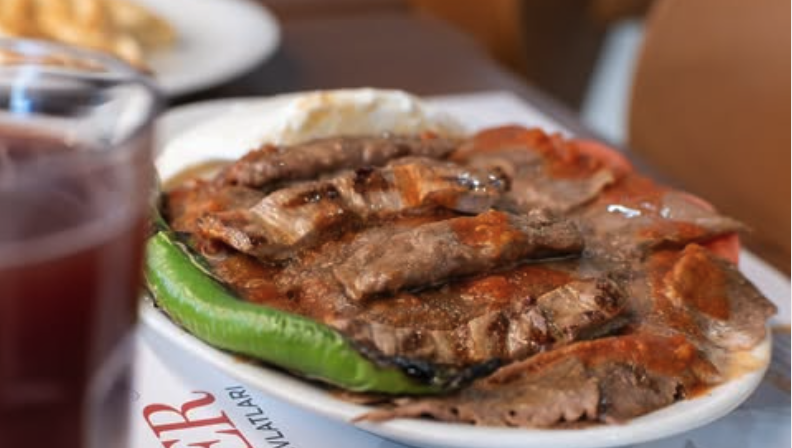
İskender Kebab
🍛 Thinly Sliced Döner with Yogurt & Tomato Sauce
Originating from Bursa, İskender Kebab is made from thinly sliced döner kebab served over pita bread, drenched in tomato sauce, and finished with melted butter and yogurt. Best With: Ayran (Turkish yogurt drink)
Kebabçı İSKENDER – a legendary and local favorite since 1897.

Çöp Şiş (Trash Skewers)
🍢 Mini Skewers of Marinated Meat
This dish originated from Aydın, where butchers would use leftover small cuts of lamb, marinate them in olive oil, garlic, and spices, and grill them on tiny skewers. Best With: Bulgur pilaf, grilled peppers, and Turkish pickles.
Bilice Kebap – A great place to try authentic çöp şiş in Istanbul.

Kuzu Şiş (Lamb Shish Kebab)
🥩 Marinated Lamb Skewers, Grilled Over Charcoal
Unlike Adana or Urfa kebabs, Kuzu Şiş features cubed pieces of marinated lamb grilled on skewers, offering a juicy, smoky flavor. Best With: Tabbouleh salad and grilled onions.
Tatbak – Known for its succulent lamb skewers in Istanbul since 1960.
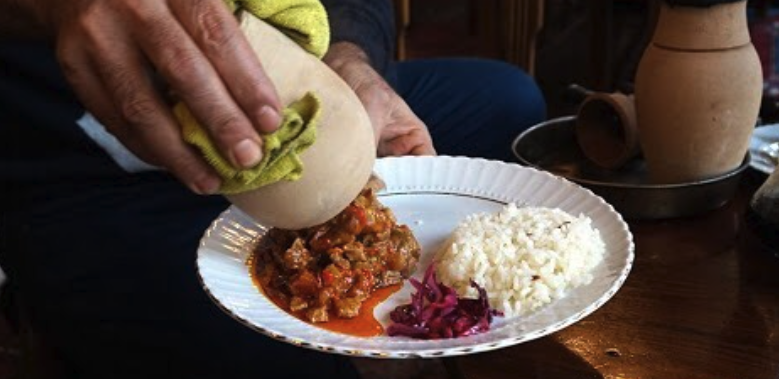
Testi Kebabı (Clay Pot Kebab)
🥘 Stewed Meat Cooked in a Sealed Clay Pot
A local delicacy to Nevşehir, this kebab is slow-cooked in a sealed clay pot, filled with lamb or beef, vegetables, and spices. It’s hard to find it throughout Turkey as it’s specialized to Cappadocia. The pot is cracked open at the table for an unforgettable dining experience. Best With: Pide bread and a glass of Turkish red wine.
Dibek Restaurant, Cappadocia – where Testi Kebab is a specialty.
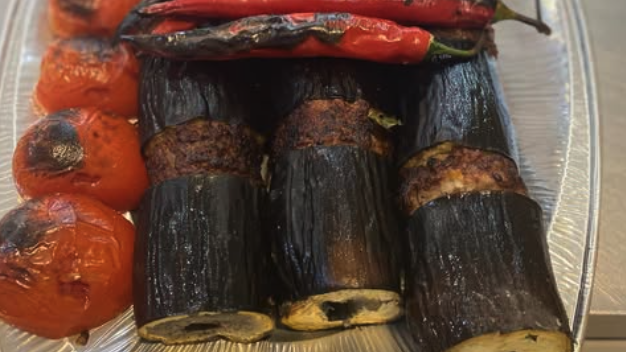
Patlıcan Kebabı (Eggplant Kebab)
Alternating Layers of Lamb & Eggplant on a Skewer
This Gaziantep-origin dish consists of alternating chunks of lamb and eggplant, grilled together so that the eggplant absorbs the smoky, juicy flavors. Best With: Tahini sauce and bulgur pilaf.
Kebapçı Osman Usta 1976 – down a small side street find this shop specializing in eggplant kebab.
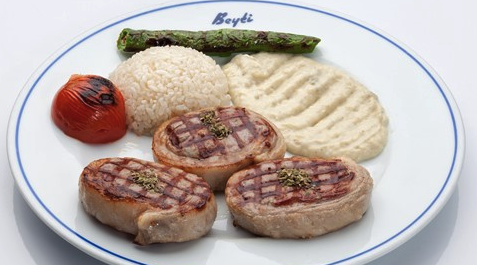
Beyti Kebab
Wrapped Minced Meat with Yogurt and Tomato Sauce
Named after Beyti Güler, the chef who created it, Beyti Kebab is made from minced lamb wrapped in lavash bread, topped with tomato sauce and yogurt. The cooking process is unique – the meat rests for 12 days, then is marinated in onion juice, vinegar, and extra virgin olive oil for three more days, then pieces from the back strap and filet are rolled, then rest for a further day. Finally, it is sliced and grilled – the fat on the outer layer ensures the meat stays tender and flavorful. Best With: A side of grilled tomatoes and peppers.
Beyti Restaurant – where it is a specialty.
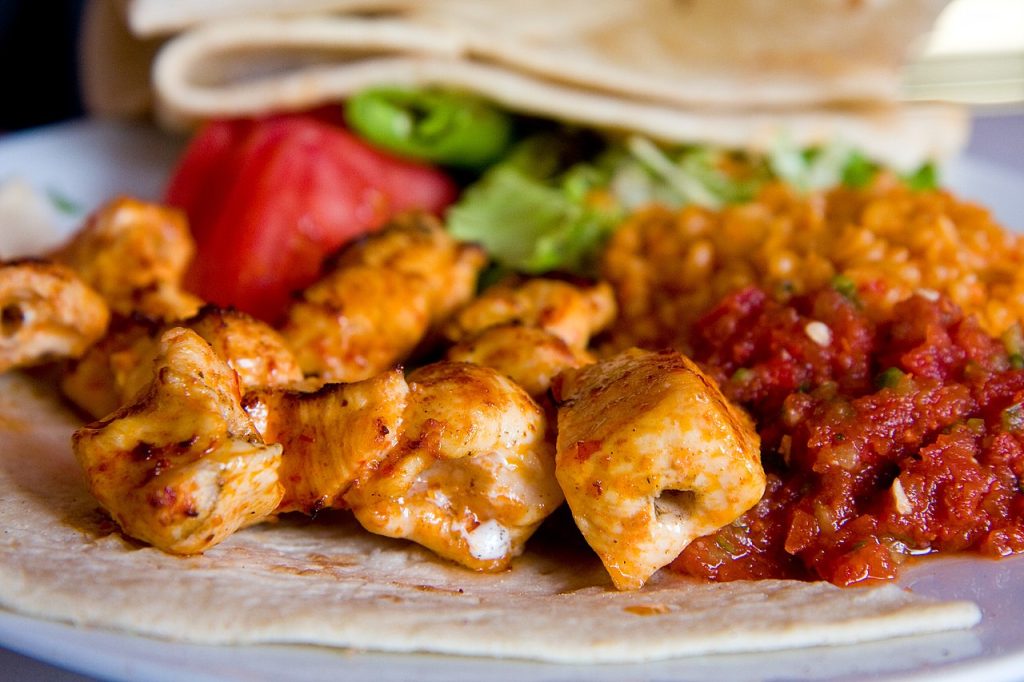
Tavuk Şiş (Chicken Shish Kebab)
🍗 Marinated Chicken Skewers
For those who prefer poultry over lamb, Tavuk Şiş is grilled marinated chicken, often flavored with yogurt, paprika, and garlic. Best With: Hummus and a side of sumac onions.
Dürümzade, A street-food favorite (yes, Anthony Bourdain did visit) – we could have listed it above, but this is such an excellent list of kebabs!

Step 5: Baklava
Baklava, with its layers of flaky pastry, nuts, and sweet syrup, is a dessert that has transcended borders. Its rich sweetness offers a perfect conclusion to any meal. There are
There is no consensus about where baklava originated – some think it was born in Greece, others think it came out the kitchens of medieval nomadic Turks – either way, baklava was once a dessert reserved for the elite. Today, it is enjoyed by all, especially during festive occasions and celebrations.
Karaköy Güllüoğlu is a historic establishment known for its traditional baklava, made with pistachios and a closely guarded family recipe. For an elite twist, Hafız Mustafa 1864 offers exquisite gift boxes and varieties with chocolate.
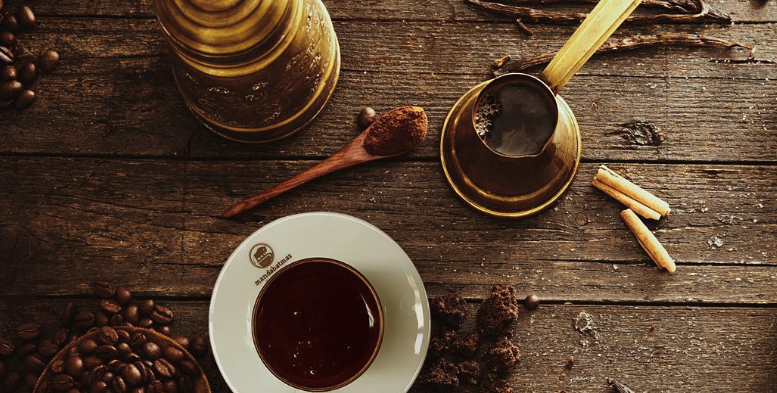
Step 6: Turkish Coffee
Turkish coffee is more than a beverage; it’s a centuries-old tradition. The finely ground coffee, brewed in a cezve, is strong, unfiltered, and often accompanied by a piece of Turkish delight.
The cezve (pronounced “jehz-veh”) is a small, long-handled pot typically made from copper, brass, stainless steel, or even ceramic, and features a wide base and narrow neck to help control the foam that forms during a centuries-old brewing method that dates back to the Ottoman Empire.
Order authentic Turkish coffee from Mandabatmaz, or visit the cafe – a legendary spot in Beyoğlu (Olivia Geçidi 1/A, Beyoğlu (near St. Antoine Cathedral on İstiklal), where the coffee has been prepared authentically since the late 1960s.